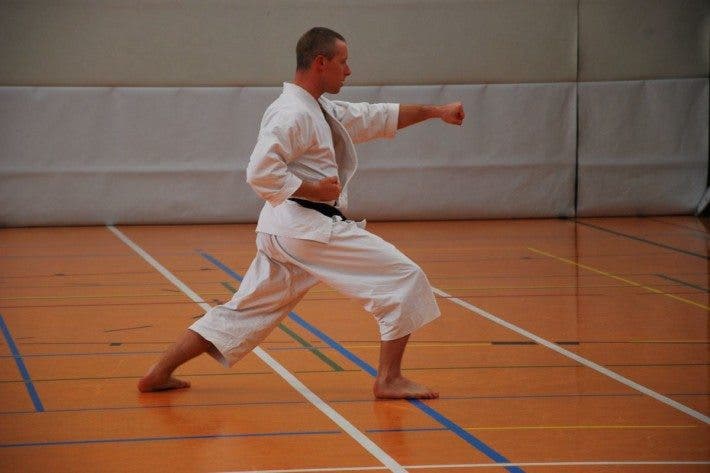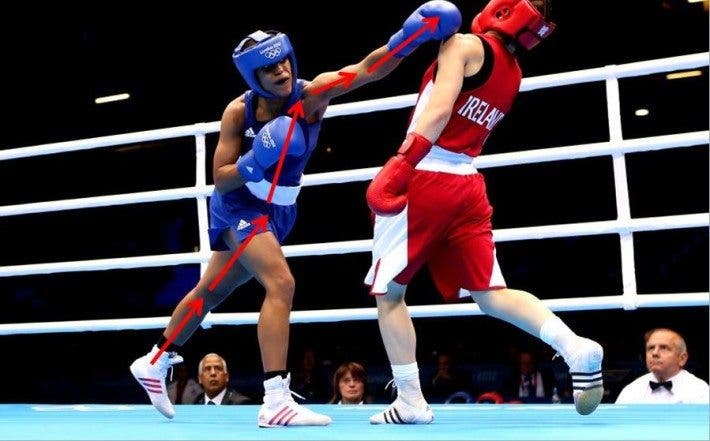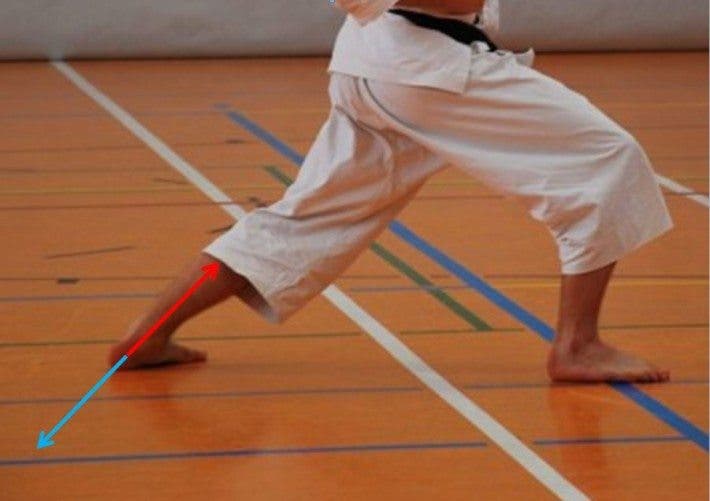In this article we are going to enter fully into the world of martial arts (or fighting sports, depending on how you look at it) to carry out a biomechanical analysis of one of the most important techniques and common to a large number of them, the punch. direct cross. To make the writing more comfortable, I am going to use the term used in karate to name this technique, which is: “gyaku-tsuki” (although what we are going to talk about can also be applied to boxing “cross”). And so that there are no doubts about what we are talking about here, I leave two images.


As we can see, in the two images the same blow is being made: a direct punch embedded with the hand opposite the forward foot of the guard, regardless of the technical characteristics of each sport and the height at which it is performed. Without a doubt, it can be said that this is the most powerful punch that can be performed, and to achieve this we are going to study the blow biomechanically in this article.
To better understand this purpose, first we have to know what sports biomechanics is, well, it is the science that is responsible for applying the laws of physics to human movement , studying the different specific movements of sports to achieve greater efficiency and possible efficiency of the same. Therefore, a biomechanical analysis will aim to find the most efficient and effective motor pattern to achieve a certain purpose (be it hitting harder, jumping more, throwing farther or running faster). Thus, sports biomechanics will be mainly responsible for analyzing the technique of different sports. Other aspects of sports biomechanics use these analyzes to apply them to the different technologies that are being applied to sports materials, these being one of the branches that have been advancing the most for years.
What is hitting hard
Normally we hear the terms of hitting hard, hard or powerful when we talk about the subject at hand, however strength and power are not the same, therefore, the confusion of not knowing whether to train to increase maximum strength or power can be created. However, if we analyze this possible doubt from a biomechanical point of view, it will be easily clarified.
As we have just seen, biomechanics consists of applying the laws of physics to human movement, therefore, to know what it is to hit hard, we must first know what the force, which was defined by Newton in his 2nd law of motion:
The change in motion is proportional to the printed motive force and occurs according to the straight line or along which that force is printed.
From this statement we can extract that the force is something capable of causing acceleration in a certain object, that is, it causes a mass to move (f = m · a) . Likewise, the greater mass and acceleration we imply in our blow, the greater the impact force we will obtain, and the greater displacement our objective will suffer. If you are understanding everything so far, there must be something that is strange to you, when we refer to hitting hard, we are not talking about moving our opponent very far, we also get that by pushing without meaning that we are hitting hard, in fact, the blows that cause a greater impact in combat usually do not translate into a large displacement of the target. Therefore, this concept of force is a bad indicator to measure the power of our blows.
What happen? a push differs from a hit in the deceleration suffered by the movement just before impact, thus, the more deceleration, the less speed your blow will carry, and the less impact it will cause on the target. So, how hard or hard you hit will depend more on the speed of your hit just before impact, this concept is defined in physics as Momentum (M) , and its formula is M = m · v. Now our objective will be to achieve greater momentum, or speed at the moment of impact, how do we achieve it? managing to increase the speed and mass involved in the blow, through the transfer of that momentum through the body, that is, using a kinetic chain in which other masses and speeds of other body segments participate that transfer that achieved energy towards the right place, our fist. Hence the famous importance of using the hips and waist in fist blows, a punch through a kinetic chain that transfers momentum through the body will be much harder than a punch whose impulse is born in the body. shoulder and only uses a small body segment (the arm) to strike.
A lot of information? Let’s think of a whip, through a force applied to the handle of the same we manage to accelerate the different segments of it, transfer the momentum, so that in the end, the tip of the whip reaches a speed much greater than that applied to the handle, and so its impact is harder. That same mechanic is what we want to achieve with the body, transferring the momentum from the back leg, passing through the hip, waist and shoulder until it ends in our fist.

Another way of calling this momentum transferred through the organism is impulse , whose physical equation is: I = F · T , from which we can extract that: F = I / T. From these equations we deduce that to seek greater momentum, and with it, a harder impact, we must increase the momentum, that is, transfer the momentum effectively. To achieve this we must apply a greater force in the shortest possible time. In this way, according to various studies, with an optimally transferred momentum, a punch of the characteristics that we are studying would reach its maximum speed at 80% of its development.
Another question, the last one that I am going to bring up in this article, in which I believe that there is already enough information to assimilate. Where does this impulse come from? We have seen that we want to transfer a force (momentum) through the organism in the optimal way, but where does it start. To study it we have to go back to Newton’s 3rd Law, the Action-Reaction Principle , in Newton’s words:
With every action an equal and opposite reaction always occurs: it means that the mutual actions of two bodies are always equal and directed in the opposite direction.
That is, when we apply a force on a body, as a response we will receive another force equal to and in the opposite direction to the one we have applied. If we push a wall with a force of 5 N, the wall will exert another force of 5 N on us in the opposite direction. Thanks to this law we can also understand the recoil we suffer when we fire a weapon. Also thanks to this law we can understand that the impulse when we perform the action of a gyaku-tsuki or a cross is born in the back leg of our guard (the leg on the same side of the fist that is going to hit in this case). When we are going to carry out the action, we produce a small movement of our body forward, which is due to the fact that we have exerted a force against the ground, we have “pushed the ground”, and it has returned it to us with another equal and meaningful force On the contrary, we will try to transmit through our body, increasing its speed and mass to achieve the greatest possible momentum before impact and thus achieve a really hard hit (although this does not mean displacing our objective).

Conclusions from these theories
Some biomechanical studies on this technique in karate demonstrate these theories by measuring the displacement speed of the different body segments and concluding that a higher speed in the distal segments translates into a higher speed in the most proximal segment of the blow, the fist.
As important as the speed of movement is the sequences of action, to transmit the force it is necessary that each segment act at the ideal moment, so that if it does not do so, the effect of the kinetic chain will be lost and the impact will be much less .
Another aspect to take into account is the proximal muscles of the body (the core or the abdominal waist). The reason that a force will be transmitted optimally when the body through which it passes is as hard as possible, since if it is not, part of that force will be dissipated in the deformation of the body. In other words, if we do not have a strong enough abdominal waist, the force that will pass through there will be diverted and the kinetic chain, again, will lose its effect.
To finish, I just hope that all these concepts have been clear, if not, I will be happy to answer questions in the comments, as well as accept suggestions to analyze other biomechanically sports gestures in future articles.
Bibliographic references
- http://dandjurdjevic.blogspot.com.es/
- Gutiérrez Dávila, M. (1998). Sports biomechanics. Editorial Synthesis.
- Wallace, B. (2005). Secrets of the punch. Black belt, vol. 45, issue 3.
- Ionete, G., Mereuta, E., Mereuta, C., Tudoran, M. and Ganea, D. (2011). Experimental study on kinematics of Gyaku-Tsuki punch. The annals of “Dunarea de Jos” University of Galati.
- Iwamoto, N., Imai, S., Saito, T. (2014). Examination of differences by experience of the straight punch motion in boxing. Rigakuryoho Kagaku.
- Ionete, G., Mereuta, E., Mereuta, C., Tudoran, M. and Ganea, D. (2011). Linear kinematic analysis of gyaku-tsuki karate technique. The annals of “Dunarea de Jos” University of Galati.
- Nakano, G., Lino, Y., Imura, A. and Kojima, T. (2014). Transfer of momentum from different arm segments to a light movable target during a straight punch thrown by expert boxers. Journal of Sports Sciences: Vol 32, Issue 6.
